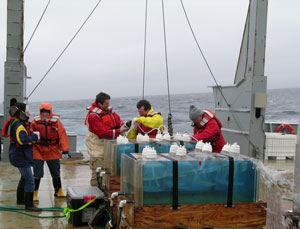Adding minute quantities of iron to ocean waters to lock away excess carbon dioxide is believed to trigger the growth of microscopic algal blooms, which consume vast amounts of carbon dioxide, removing it from the atmosphere and storing it in the deep sea for centuries.
But William Cochlan, a senior research scientist at San Francisco State University’s Romberg Tiburon Center for Environmental Studies, said that such iron enrichment would likely favour the growth of Pseudo-nitzchia, a group of phytoplankton species that produce a potent neurotoxin that causes the human illness Amnesic Shellfish Poisoning.
The naturally occurring biotoxin, called domoic acid, could put human health at risk if accumulated in shellfish, and can damage marine mammals and seabirds that feed on small fish that feed on plankton. In coastal systems, these toxic blooms contaminate organisms such as shellfish and could cause economic losses through the closure of commercial fisheries.
Ship-based experiments conducted by the researchers in the subarctic Pacific Ocean near the Gulf of Alaska found that iron enrichment increased the concentration of the toxin produced by each Pseudo-nitzchia single-celled organism.
The scientists also found that in water samples enriched with iron, the population of the toxic algae Pseudo-nitzchia doubled in nine days relative to control samples, suggesting that the addition of iron creates conditions that give the toxic species an advantage over non-toxic species, increasing the chances of an ecologically harmful outcome.






Glasgow trial explores AR cues for autonomous road safety
They've ploughed into a few vulnerable road users in the past. Making that less likely will make it spectacularly easy to stop the traffic for...